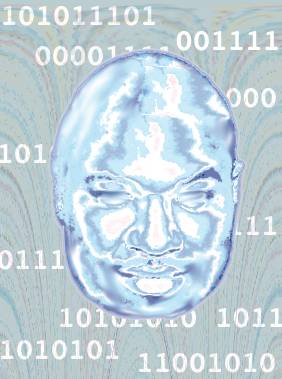|
|
|
What is Intelligence?
|
|
Chong Ho Yu,
Ph.D. |
Optional reading. This chapter may be too theoretical for most students.
Summary
In order to measure and access intelligence, first we must define what intelligence is.
In the late 1980s and 1990s, there are two major approaches to answer the preceding question, namely, John Anderson's Adaptive
Character of Thought-Revised (ACT-R) and Minsky's Parallel Distributed Processing (PDP).
|
|
ACT
|
PDP
|
|
Basic Unit
|
Node and link
|
Frame
|
|
Information Processing
|
Top-down
|
Bottom-up
|
|
Source
|
Goal-directed
|
Data-driven
|
|
Reference
|
Rule-based
|
Example-based
|
|
Nature of Intelligence
|
Intellectual process follows the rule of logical branching such as "if-then" deduction. The parts must be comprehensible and logical to match the production rules.
|
When ambiguous pieces of a puzzle are being put together, eventually the whole picture will be clear from the induction.
|
Analogy of Computer Information Processing
|
 |
Can the intelligence of a silicon-based life form be compared to that of a carbon-based life form?
|
-
Since the invention and popularization of computer technology, cognitive theories tend to compare human perception, thinking, and decision-making to input, processing and output
(Pylyshyn, 1989; Schwartz, 1988).
-
Anderson parallels vectorized and recursive procedures in LISP (LISt Processing) with human cognition.
-
PDP modeled after parallel processing of supercomputing.
-
Computer data processing and human mental processing become an analogy to each other. Psychologists study computing to understand human mind and scientists study the human cognition for
artificial intelligence.
ACT
-
Based on evolution, Anderson (1983, 1990, 1993, 1996) maintained that humans are adaptive to the environment. The complexity of intelligence is developed in response to the complexity of
the environment.
-
In our mental structure there is a long term declarative memory in the form of a semantic net, or "chunks," and a long term procedural memory in the form of
production rules.
-
The representations of information, which are symbols, are stored in associative nodes or links, similar to those implemented by LISP. Those symbols could be highly abstract
categories and constitute a schema.
-
Complex cognition arises from an interaction of procedural and declarative knowledge.
-
Also, there is a short term memory functioning as working memory, which can spread activation throughout the semantic network by production rules. Working memory contains
goals that serve as the base of activation.
-
In his view, declarative knowledge must be semantically meaningful, and the procedural knowledge is logical and therefore productive. More importantly, information processing is
goal-directed. Hence, ACT is called a production system.
PDP
-
Minsky regards the "frame," which is a set of information, rather than the "node," as the primary unit of storage. The core idea of the frame is that all knowledge concerning
individual datum and their relationships are stored in a complex entity called a frame.
-
Inside the frame there are many slots. Incoming data fill in the slots and become slot values. When more and more slot values are accumulated, an overall pattern is formed. (The
basic idea underlying the notion of frame could be found at the beginning of this century by the psychologist O. Selz. He suggested that human problem solving is the process of filling in
the gaps of partially completed information.)
-
Moreover, a representation of information is stored, not by making a single, substantial change in one slot or one frame, but by making small changes in many different agents. In other
words, information is distributed throughout the whole network. Therefore, this model is called Parallel Distributed Processing.
-
Every single slot value may not be meaningful but the overall pattern composed by the distributed memory is meaningful. In Minsky's words (1986), many smaller non-intelligent agents build
up "the society of mind." (p.20)
Human reasoning transcends computation
-
British mathematician Roger Penrose (1989, 1994, 1997) argued against comparing human reasoning to formal algorithms. His notion is mainly an objection to the optimist view held by the artificial intelligence community that all thinking is computational and thus can be simulated in a computer. Nonetheless, Penrose's notion has a lot of implications for educational psychology and psychometrics.
-
Penrose insisted that humans know something to be true and build up insight that a computer is incapable of doing so. Correct computation by an automated process does not constitute understanding.
-
Penrose's work is based upon Kurt Godel's Gödel Theorem, and John Searle's Chinese room experiment. According to the
Gödel Theorem, within any consistent mathematical system there are propositions that cannot be proved or disproved on the basis of the axioms within that system. By the same token, a set of algorithm cannot "realize" that the algorithm is true.
-
According to Searle, if someone inside a room has a Chinese code cook, The input in the form of Chinese language can be decoded and encoded again to output some apparently meaningful Chinese text by that person. However, this is just a syntactical processing, rather than a semantic processing.
Android epistemology and Bayes Net
-
Philosopher Clark Glymour (2000), who worked closely with cognitive
psychologist Patricia Chen, and developmental psychologist Allison
Gopnik, argued against the notion of decomposition:
Apparently indivisible intelligent capacities is composed of a
complex of less intelligent component sub-capacities (Minsky's
"Society of mind")
-
In the past developmental psychologists regarded kids as Einstein
machine. Sometime they got "E=MC" and sometime, "E=MC3".
But eventually the Einstein machine can converge to the right
answer: "E=MC2".
The real Einstein is smart but the Einstein machine is dumb.
However, Gopnik said that actually children are more like the real
Einstein than the Einstein machine. They are capable of forming
theories, making observations, and revising their theories.
-
Glymour (2001) developed the Causal Bayes Net to explain how
causal inferences are made in our mental process. In this view,
human mental process is moving away from the computer analogy.
-
National Research Council (2004) asserted that Bayesian modeling may
become a dominant approach to the technical aspects of modeling in
assessment. The learner's mental process is viewed as a web of
knowledge: What one can know depends on certain prior knowledge and
background information. In other words, Bayes nets reply on
conditional independence relationships.
Review Quiz
References
Anderson, J. R. (1983). Cognitive Psychology and Its Implications. San Francisco, CA: W. H. Freeman and Company.
Anderson, J. R. (1990). The Adaptive Character of Thought. Hillsdale, New Jersey: Lawrence Erlbaum Associates.
Anderson, J. R. (1993). Rules of the mind. L. Erlbaum Associates: Hillsdale, N.J.
Anderson, J. R. (1996). ACT:A simple theory of complex cognition. American Psychologist, 51, 355-365.
Anderson, J. R. ∓ Bower, G. H. (1973). Human associative memory. Washington, D. C.: V. H. Winston.
Glymour, C. (2000). Android epistemology for babies: Reflections on
words, thoughts, and theories. Synthese, 122, 53-68.
Glymour, C. (2001). Mind's arrows: Bays Net and graphical causal
model in psychology. Cambridge, MA: MIT Press.
Minsky, M. (1975). A framework for representing knowledge. In P. H. Winston (Ed.), The Psychology of Computer Vision (pp. 211-277). New York: McGraw-Hill.
Minsky, M. (1986). The society of mind. New York: Simon and Schuster.
National Research Council. (2004). Knowing what students know.
Washington, DC: National Academy Press.
Penrose. R.(1989). Emperor's new mind concerning computers, minds, and the laws of physics. Oxford: Oxford University Press.
Penrose. R.(1994). Shadows of the minds: A search for the missing science of consciousness. Oxford: Oxford University Press.
Penrose. R.(1997). The large, the small, and the human mind. Oxford: Oxford University Press.
Pylyshyn, Z. W. (1989). Computing in cognitive science. In M. I. Posner (Ed.). Foundations of Cognitive Science (pp.49-92). Cambridge, MA: MIT Press.
Navigation

Press this icon to contact Dr. Yu via various channels
|